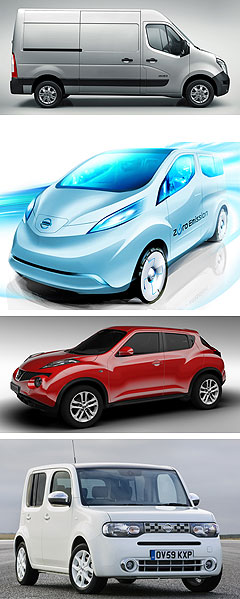No Nissan van action for ‘a couple of years’
BY TERRY MARTIN | 5th Aug 2011

Although the Japanese manufacturer has introduced the large-sized NV400 van – a twin with the Renault Master – and the all-new NV200 compact van in overseas markets, Nissan Australia chief executive Dan Thompson this week admitted to rejecting multiple business cases for both models.
Despite the fact that Nissan Motor Co has announced plans under its new ‘Power 88’ strategy to become the global market leader in light commercial vehicles by 2016, Mr Thompson said he refused to compromise with models that did not meet Nissan’s core brand value in Australia – innovation – and which did not offer enough sales volume potential to justify the investment of launching here.
The key problem remains the lack of a new-generation medium-sized van that would compete directly with the market-leading Toyota HiAce and Hyundai iLoad – a situation that could be rectified with a wide-ranging alliance forged last year with Daimler, which includes collaboration on LCVs.

“Vans have been a struggle for us,” Mr Thompson said.
“Globally, a lot has gone into expanding the range and the offering and improving the competitiveness of the product, but I’ve always stayed very, very firm – because we’ve probably looked at 10 different business cases over the last three years – if it doesn’t work, we’re not bringing it in.”Asked to explain what the problem was, Mr Thompson said the van segment had shifted significantly with the introduction of the highly regarded Hyundai iLoad – which starts from $29,990, is well specified and offers a choice of petrol or diesel power – “and that’s thrown a bit of a monkey wrench into what we need to deliver”.
“Obviously, the Europeans have also been much more active in that space over the last few years, so I’ve rejected many, many proposals to bring in specific van product,” he said.
“I think we’re about 90 per cent of the way there finally getting the right product, but it will be a couple of years out.
“It has to be competitive. Powertrain is one key for us, second is price – to be very direct, there’s been a lot of downward pressure on pricing in that space – and the last one is we have to step back and realise that as part of our GT2012 plan, which is aggressive growth, if I sold every van that sold here (across all brands), that’s 20,000 (a year).
“There aren’t a lot of vans here that are sold, so vans have never been a top priority for us ... It’s such a crowded space, and it’s important for me to own a space with a product, otherwise it’s not worth our time.
“We have that philosophy for all our non-core models – if it’s not going to work, and deliver on the brand, and do it profitably, it’s not worth it. That’s why we don’t have Cube. That’s why we don’t have Juke. We don’t have a lot of great global product because it doesn’t fit, it adds complexity and takes away from our focus on the top four.” The latter refers to Nissan’s core volume-selling models – Navara, X-Trail, Micra and Dualis, although the latter will step down from this position when the Tiida small car replacement arrives in the first quarter of 2013.
Mr Thompson said he hoped that Nissan’s strategy to become the worldwide leader in LCVs would bring “more of that innovation and investment into the product line-up” that could hand the Australian subsidiary at least one model with which it believes it could succeed.
Part of the requirements, he said, was that the van was compatible with Nissan’s brand perception under the current regime – “and vans pose a challenge there”.
“I don’t want to bring in an average product, because that’s not what Nissan is about,” he said.
“If we’re going to bring in models that are not core product – the GT-Rs, the Zeds, the Muranos – they have to hit smack on where the brand is going. The brand for Nissan is heading in a direction around innovation ... so when we deliver a brand, it must deliver on that brand promise or pillar. If it doesn’t, it’s not the right product. So we’re not going to compromise.”Last year, 23,000 new vans were sold in Australia, with the market dominated by the HiAce (7610 units for a 33 per cent share) and the iLoad (5990, for a 26 per cent of the market).
The remaining 9400 sales were spread across 14 other models, including the European-developed Ford Transit, Volkswagen Transporter and Caddy, and Mercedes-Benz Vito.
An all-electric version of the NV200 is earmarked as the next EV to be sold by Nissan in Australia, but Mr Thompson admits this is a long way off and will not be part of the launch line-up if/when the compact van eventually makes it Down Under.